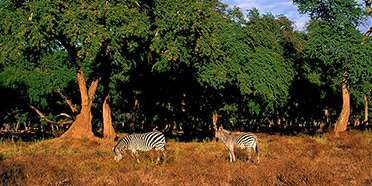- You are here:
- Home
- Countries & Parks
- Zimbabwe Parks
- Chizarira National Park
- Reviews
- Expert Reviews
Expert Reviews – Chizarira NP

Emma is an award-winning travel writer for Rough Guides, National Geographic Traveller, Travel Africa magazine and The Independent.
4 people found this review helpful.
Seclusion Close to Lake Kariba
Lying southeast of Lake Kariba, Chizarira looks reasonably near Hwange, Matusadona and Harare on the map, but once you’re there it feels extremely remote.
I wouldn’t recommend Chizarira to anyone who’s primarily interested in Big Five wildlife watching: there are elephants here, and some rare antelopes, but it doesn’t have anywhere near the same concentrations of animals as Zimbabwe’s flagship parks, Hwange and Mana Pools. The main reasons I like it are for its picturesque scenery, with rugged escarpments, deep gorges and fine lake views, and for its peaceful, wilderness quality. It’s also a great place to go hiking along elephant tracks and highland trails with a guide. The accommodation options amount to a few wilderness campsites, there are no tarmac roads, and very few tourists visit.

Paul is a travel writer, author of the Bradt guidebook to Zimbabwe and is closely involved in promoting tourism to Zimbabwe.
1 person found this review helpful.
The Gorges Are Gorgeous
Very few people come here as it’s way off the beaten track, but Chizarira is a stunning park with pristine forests and deep gorges along the Zambezi escarpment, making it one of the few remaining true wilderness areas in Zimbabwe. Poaching has taken its toll, so although there are lion, leopard and hyena with their attendant prey species, including sable, tsessebe, roan, kudu, giraffe and other plains game, they are all wary of humans, as are the elephants. When you do see them, it really makes your day, so this park is better suited for the more experienced safari visitor. It’s very underdeveloped and there’s currently no accommodation, so you’ll probably come here with one of the specialist operators who camp and walk in the park, rather than drive. I’ve had some magical nights camping here, sometimes perched right on the edge of the dizzying Mucheni Gorge, other times on a basic platform overlooking a valley, or by a small river in a secret, wooded environment.
The birdlife is fantastic with the rare Taita Falcon patrolling the cliff faces as well as the holy grail of birders, the African (Angola) Pitta, in the forest undergrowth. You should plan for the dry season as many of the tracks are impassable during the rains.

Lizzie is a reputed guidebook writer and author of the Footprint guides to South Africa, Namibia, Kenya, Tanzania, Uganda and Zimbabwe.
1 person found this review helpful.
Impressive Views of the Zambezi Valley but a Challenging Destination With Limited Game-Viewing
South of Matusadona National Park, Chizarira is rarely visited and for good reason: it’s remote, wild and very difficult to access (in the rainy season virtually impossible). On my visit, we encountered only forbidding barely-there rutted and rocky tracks. But we did make it to the very basic Mabula campsite four kilometres from the park gate and located right on the edge of the Zambezi Escarpment. Here we were rewarded with a spectacular view of high ridges of hills cut by near-sheer gorges and Lake Kariba beyond. While most game species are present in Chizarira, it doesn’t have the large and visible concentrations of animals for which other parks like Mana Pools are famous. However, for the well-equipped 4x4 adventurer, its strong points are the varied scenery and that elusive attribute known as 'wilderness quality'.

Stephen is a travel writer and avid conservationist whose work appears in prestigious magazines such as Africa Geographic and Travel Africa.
Zimbabwe’s Wildest Wilderness
While it is one of Zimbabwe’s largest and most beautiful national parks, Chizarira is also one of Southern Africa’s least well-known wildlife reserves. Lovers of wilderness and solitude will find Chizarira enchanting with its incredible views across the Zambezi Valley to Lake Kariba. There are few tourists and virtually no paved roads in this wild park, and the only accommodation option is camping. Somewhat surprisingly, quite a bit of money has recently been spent on upgrading the park’s run-down infrastructure. Chizarira was once a black rhino stronghold, but sadly no longer and, although wildlife numbers have suffered, we did see hundreds of waterbuck and a decent array of general game as well as elephants. Nonetheless, I would say Chizarira’s greatest appeal is its scenic beauty, spectacular vistas, wonderful birdlife and wild wilderness vibe.

Kim is a travel writer who authored and updated over 15 guidebooks, including Lonely Planet's South Africa and Bradt's Tanzania guides.
Into the Wild
Zimbabwe’s wildest and most remote national park is also its least visited. Spanning the dramatic folds of the Zambezi escarpment overlooking Lake Kariba, it is known more for its scenic beauty than for its concentrations of game. But you don’t come here for the Big 5; you come here for the bush experience. That doesn’t mean there aren’t any animals. In fact, leopards are known to roam the rocky terrain, though I’m yet to spy any. If you’re up for the exercise, then I recommend you take a guided walking safari. It’s the best way to appreciate the sheer magnitude and tranquillity of the park. Our sightings were limited to a troop of baboon, a few small herds of skittish impala, a shy duiker, a pair of klipspringers and two old buffalo bulls that stormed away on our approach, but it’s the sense of isolation and wild frontier appeal that I like most about Chizarira. And there’s no better way to soak it all in than with a G&T at the end of the day watching the sun set over the Zambezi Valley.


 Zimbabwe Parks
Zimbabwe Parks